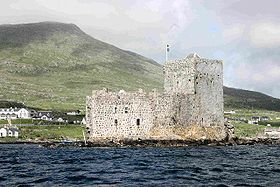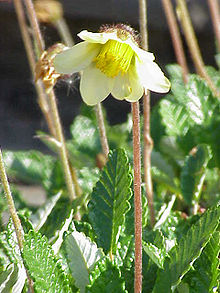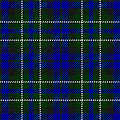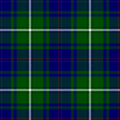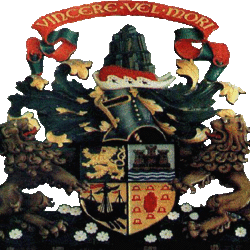- Clan MacNeil
-
Clan MacNeil Crest badge 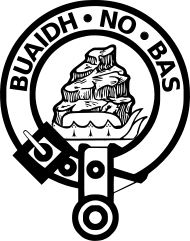
Motto: Buaidh no bas Profile Region Highland and Islands District Western Isles Plant badge Dryas Chief
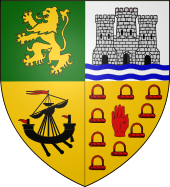
Roderick Wilson Macneil of Barra The Macneil of Barra, Chief of Clan Niall and 27th of Barra, Baron of Barra Historic seat Kisimul Castle Clan branches MacNeil of Barra
MacNeill of Gigha/ColonsayClan MacNeil, also known in Scotland as Clan Niall, is a highland Scottish clan, particularly associated with the Outer Hebridean island of Barra. The early history of Clan MacNeil is obscure, however despite this the clan claims to descend from the legendary Niall of the nine hostages. The clan itself takes its name from a Niall who lived in the 13th or early 14th century, and who belonged to the same dynastic family of Cowal and Knapdale as the ancestors of the Lamonts, MacEwens of Otter, Maclachlans, and the MacSweens. While the clan is centred in Barra in the Outer Hebrides, there is a branch of the clan in Argyll that some historians have speculated was more senior in line, or possibly even unrelated. However, according to Scots law the current chief of Clan Macneil is the chief of all MacNeil(l)s.[1][2]
Contents
History
Origins
MacNeils of Barra
The MacNeils of Barra claim descent from a prince of the O'Neill dynasty, Ánrothán Ua Néill, son of Áed, son of Flaithbertach Ua Néill, King of Ailech and Cenél nEógain, died 1036. Anrothan emigrated to Scotland in the 11th century. Through him the MacNeils of Barra also naturally claim descent from the legendary Niall of the Nine Hostages. Anrothan is claimed as ancestor of several clans in the Argyll vicinity: Clan Lamont, Clan Maclachlan, Clan MacEwen of Otter, and also the Irish Sweeneys (MacSween). If the MacNeils are indeed connected to Anrothan, then they appear to have been a junior branch of the family and were certainly overshadowed in the 13th century by the MacSweens, Lamonts and descendants of Gilchrist.[3] An opposing theory, proposed by Nicholas Maclean Bristol, is that there is reason to believe that they descend from Neill Maclean who appears on Exchequer Rolls at a time when Tarbert Castle was being rebuilt by Robert the Bruce.[4] The earliest contemporary record of the Macneils of Barra is only in 1427, when Gilleonan Macneil received a charter of Barra and Boisdale.[1]
 Castle Sween. MacNeills from Argyll are thought to have been hereditary keepers of the castle in the 15th and 16th centuries
Castle Sween. MacNeills from Argyll are thought to have been hereditary keepers of the castle in the 15th and 16th centuries
McNeills of Argyll (in Taynish, Gigha and Colonsay)
The origins of the Argyll MacNeills is also obscure. In the late 15th century, one MacNeill is recorded as the keeper of Castle Sween. In the mid 16th century, a certain Torquil MacNeill was known as the "chief and principal of the clan and surname of Maknelis". The 19th century scholar W.F. Skene considered Torquil to be the last of the hereditary MacNeill keepers of the castle. Skene believed that after Torquil's demise, the hereditary office passed to the MacMillans. During the time of Torquil, there are records of separate clans on Barra and Gigha. Skene did not consider Torquil to be a member of either of these clans, since both clans had chiefs of their own.[5]
The chief of the Gigha MacNeills at this time was Neill MacNeill, who was killed in about 1530. His only daughter inherited his lands and handed them over to her illegitimate brother, Neill. According to historian John Bannerman, while the lands of the chief passed to his daughter, the chiefship passed over to Torquil who was her second cousin. Bannerman considered it likely that when Torquil died, the chiefship passed to the illegitimate Neill.[6]
In 1553, this Neill sold the island to James MacDonald of Islay. Neill died without issue, and the next in line to the chiefship was another Neil, who obtained the lands of Taynish. His descendant Hector Macneill of Taynish purchased Gigha in 1590. With the power of the Campbells growing and spreading out into the Inner Hebrides, the influence of the McNeills of Gigha decreased.[7] At about this time the MacNeils on more remote island of Barra, far removed of Campbell power, began to grow in prominence and for a long time since have been regarded as Chief of the Clan and Name.[8] Descending from this branch were the MacNeils of Colonsay who obtained Colonsay in 1700 and owned it until 1904 when it was sold by John Carstairs McNeill.[8] According to Moncreiffe, there is reason to believe that historically this branch were superior to the current chiefs of the Clan Macneil.[8] There is even a school of thought that there is no relation at all between this branch of McNeills to that of Barra.[1] However, according to a 1962 decree by the Lord Lyon, the chiefs of MacNeil of Barra are chiefs of the whole name of MacNeil by Scots law.[1]
Modern Clan Macneil
The 18th and 19th century saw severe hardship to Clan Macneil clansfolk. During this era there was mass emigration from Barra to Canada, Australia, New Zealand, and the United States. During the chiefship of Colonel Roderick (c.1755–1822) Barra suffered its first mass emigrations, ironically the chief described himself as a melieuratier (an "improver").[9] One mass exodus of Barra folk was led by Gilleonan, elder son of the chief. This consisted of 370 Catholic Barra folk (about 75 families in total) who emigrated in August to Pictou, Nova Scotia.[9] In 1838 after going broke, Colonel Roderick's son and heir, Lieutenant General Roderick Macneil of Barra, sold Barra to Colonel Gordon of Cluny.[8][9] When Roderick died in 1863 the chiefship passed to a cousin (descendant of Gilleonan) who had emigrated during the mass emigrations to Canada in 1802.
Robert Lister Macneil, was born in 1889. An American citizen and a trained architect, he succeeded the chiefship of Clan Macneil in 1915. In 1937 he was able to purchase Barra and the ruinous Kisimul Castle largely using the money from his second wife. Immediately he began work restoring the castle, aided in part by funds from a British Government grant. By his death in 1970 he had completed the restoration of the castle – ancient seat of the chiefs of the clan.[10] In 2001 the castle was leased to Historic Scotland for one thousand years at the rent of £1 per year and a bottle of Talisker whisky.[11] In October 2004 the chief handed over 3,600 hectares, comprising almost all of his estate on Barra to Scottish Ministers.[12] The current chief of Clan MacNeil is Ian Roderick Macneil of Barra, The Macneil of Barra, Chief of Clan Niall and 26th of Barra, also Baron of Barra.[13] The chief is a member of the Standing Council of Scottish Chiefs.[14] The current chief, while an United States citizen, lives in Edinburgh, Scotland.[15]
Regarding the ascent of the 45th chief (Robert Lister Macneil), The Arms of the Scottish Bishoprics (1917) states:
"In 1914 Roderick Ambrose Macneil, Chief of the Macneils of Barra, died in the United States of America, being still a British citizen, leaving two sons. Paul Humphrey Macneil, the elder son, in his father's lifetime renounced his allegiance to the British Crown and became an American citizen ; in consequence of this his father in 1913 nominated his second son, Robert Lister Macneil, the petitioner, to succeed him as Chief of the Clan, and assigned to him the arms pertaining to the Chief. Robert Lister Macneil therefore petitioned the Lyon King to grant him the arms recorded by General Roderick Macneil in 1824, which were borne by his (the petitioner's father), Roderick Ambrose Macneil."[16]
Clan Symbols
Crest Badges
Clan members, who wish to show their allegiance to a particular clan and chief can wear a crest badge. Scottish crest badges usually contain the heraldic crest and heraldic motto of the chief of the clan. While clan members may wear the badge, the crest and motto within it are the heraldic property of the chief alone. A crest badge suitable for a clan member of Clan MacNeil contains the crest: on a chapeau gules furred ermine, a rock proper.[17] The motto upon the badge is: buaidh no bas, which translates from Scottish Gaelic as "to conquer or die", or "victory or death").[18]
Though not a clan in its own right, MacNeil(l)s who consider themselves of the Colonsay "branch" have used the following crest badge to distinguish themselves from the Barra "branch". This crest badge contains the crest: an armoured dexter arm with dagger; and the motto: vincere aut mori, which translates from Latin as "conquer or die".[18]
Clan Badge
Another symbol used by clan members is a clan badge, or sometimes called a plant badge. The original clan badges were merely plants worn in bonnets or hung from a pole or spear. Today, the clan badge attributed to Clan MacNeil is dryas.[19] Trefoil has also been attributed to the clan,[20] however this clan badge may actually be attributed to the McNeills of Gigha, a branch of Clan MacNeil. Trefoil has also been attributed to the Lamonts, another clan in Argyl. The Lamonts and MacNeils/McNeills both claim descent from the same O'Neill who settled in Scotland in the Middle Ages.
Tartan
There have been several tartans associated with the name MacNeil / MacNeill. However, in 1997 the chief of Clan Macneil directed members of the clan that there were only two tartans that he recognised as "clan tartans".[21] These were: Macneil of Barra and Macneil of Colonsay. The Macneil of Barra tartan has been the standard Macneil of Barra tartan for over a century.[21]
-
Macneil of Barra tartan. Has been the standard Macneil tartan for over a century.[21]
-
Macneil of Colonsay tartan. One of the two official clan tartans of Clan Macneil.[21]
-
MacNeil tartan, as published in the Vestiarium Scoticum in 1842.[22] The tartan is not recognised as a "clan tartan" by the current chief.[citation needed]
Coat of arms
In Scotland, all coats of arms belong to a single person. The coat of arms typically attributed to clan MacNeil belongs solely to the current chief of the clan. A depiction of the coat of arms is painted in the Great Hall of Kisimul Castle in Castlebay, Barra, Scotland.
This coat of arms is divided into quarters:
- Upper Left: Lion Rampant (mimicking the Royal Standard of the King of Scotland)
- Upper Right: Castle in the water (symbolizing Kisimul Castle in Castlebay)
- Lower Left: 3-masted ship (Representing either the sea-faring nature of the clan or the migration of the clan from the Ulster, Ireland to Barra, Scotland
- Lower Right: Red Hand of Ulster surrounded by nine shackles representing Niall of the Nine Hostages
Surrounding the Coat of Arms [1]:
- Crest: a Rock (same as on the clan badge)
- Chapeau: Red velvet cap lined with ermine, symbolic of a Baron
- Helm: Height of the Helmet is determined by rank
- Mantle: Fabric surrounding the Arms
- Supporters: Two lions rampant
- Compartment: The base of the Arms, made of Dryas flowers (the clan badge)
Distribution
The topic of who is a MacNeil can be a complicated one. By convention, anyone descended from a member of Clan MacNeil can claim membership. Because of the history of slavery in the United States and the Caribbean, however, many African Americans may bear a MacNeil surname. Because it was not uncommon for a female slave to bear her slave-master's child, several African American MacNeils may have legitimate descent from a MacNeil, however such descent can rarely be proven, and most African American MacNeils remain uninvolved with clan activities and do not claim descent from the clan. Generally speaking, Caucasians with MacNeil surnames number between 40,000 and 80,000 worldwide.
In the United States
- McNeil: 33,239 (rank:961) (source: 2000 US Census[23])
- McNeill: 22,383 (rank:1387) (source: 1990 US Census[24])
- MacNeil: 2,487 (rank:8716) (source: 1990 US Census[24])
- McNeilly: (rank:16430) (source: 1990 US Census[25])
- MacNeill: (rank:28690) (source: 1990 US Census[25])
In England, Wales, and the Isle of Mann
source: UK National Statistics Database 2002[26]
- McNeil: 3,522 (rank:2262)
- McNeill: 4,212 (rank:1909)
- MacNeil: 314 (rank:15845)
- MacNeill: 286 (rank:16904)
Sizable populations also exist in Scotland, Ireland, Canada, France, Australia, and New Zealand
Chiefs of Clan MacNeil
Current chief: Ian Roderick MacNeil of Barra , The Macneil of Barra, Chief of Clan Niall and 26th of Barra, Baron of Barra.[27]
The chiefs of Clan MacNeil,[28] are reckoned from Niall Noigíallach (Niall of the Nine Hostages), from whom all the MacNeil chiefs claim descent. The clan claims Niall Noigíallach as its first chief, while the current chief is reckoned as the 46th chief.
# Name Notes Year of death 1 Niall Noigíallach (Niall of the Nine Hostages) High King of Ireland also a member of the Connachta dynasty and ancestor of the Uí Néill dynastic family. Married to Rignach 405 2 Eógan mac Néill King of Aileach and Prince of Ulster, also the ancestor of the Cenél nEógain dynasty and their septs (O'Neill, O'Docherty, O'Boyle, MacNeill, etc.). Founded the kingdom of Tír Eógain in the 5th century. Married to Indorb Fionn 'the White'[citation needed] 465 3 Muiredach mac Eógain King of Aileach and Prince of Ulster. Married to Eirc[citation needed] 480 4 Muirchertach mac Muiredaig High King of Ireland in 487, King of Aileach. Married to Duaibhseach[citation needed] 5 Domnall mac Muirchertaig High King of Ireland in 559, King of Aileach 561 6 Áed Uaridnach High King of Ireland 599, King of Aileach 607 7 Máel Fithrich mac Áedo) King of Aileach, Prince of Ulster 626–630 8 Máel Dúin mac Máele Fithrich King of Aileach, Prince of Ulster. Married to Cacht[citation needed] 706 9 Fergal mac Máele Dúin High King of Ireland 709, King of Aileach. Married to Athiocht[citation needed] 718 10 Niall Frossach High King of Ireland 759, King of Aileach. Married to Eithne[citation needed] 773 11 Áed Oirdnide mac Néill High King of Ireland 793, King of Aileach. Married to Maebh[citation needed] 818 12 Niall Caille mac Áeda High King of Ireland 832, King of Aileach and Ulster. Married to Gormfhlaith Macdonell[citation needed] 845 13 Aed Finliath High King of Ireland 861, King of Aileach and Ulster. Married to Máel Muire, daughter of Kenneth MacAlpin, King of Scots[citation needed] 878 14 Niall Glúndub High King of Ireland 878, King of Aileach and Ulster. Married to Gormflaith[citation needed] 916 15 Muirceartach na Cochall Croiceann (Muirchertach mac Néill) High King of Ireland 937, King of Aileach and Ulster 943 16 Domnall ua Néill High King of Ireland 954, King of Aileach and Ulster 978 17 Muirceartach na Midhe Prince of Ulster and Tyrone 975 18 Flaithbertach Ua Néill King of Aileach and Ulster and Prince of Tyrone 19 Aodh Athlamh King of Aileach and Ulster and Prince of Tyrone 20 Aodh Aonrachan King of Aileach, Prince of Aileach and Argyll, resigned kingship to brother Domhnall in 1033 aft 1047 21 Niall of the Castle Prince of Argyll and the Norse Council of the Isles. Began construction of Kisimul Castle 22 Aodh Prince of the Norse Council of the Isles aft 1090 23 Donald Prince of the Norse Council of the Isles 24 Muirceartach Prince of the Norse Council of the Isles 25 Niall Prince of the Norse Council of the Isles aft 1263 26 Niall Og Received first charter for Barra from Robert the Bruce[29] aft 1314 27 Muirceartach 28 Roderick aft 1409 29 Gilleonan Roderick Muchard Macneil Received first recorded charter for Barra from Alexander, Lord of the Isles in 1427.[29] Married to Fynvola (Flora) MacLeod, daughter of Iain Borb MacLeod (6th chief of Clan MacLeod).[citation needed] aft 1427 30 Roderick 31 Gilleonan aft 1495 32 Gilleonan 33 Gilleonan aft 1578 34 Roderick Og Married to Mary MacLeod, the 10th chief and first female chief of Clan MacLeod 35 Roderick "the Turbulent" Married to a woman from Clan MacLean of Dowart(Duart) and later to a woman named Marion MacDonald. The children from both of these marriages fought over the title of chief of Clan MacNeil[29] aft 1601 36 Niall Og Married to Margaret MacLean[citation needed] aft 1651 37 Gilleonan Married to Catherine MacDonald[citation needed] 38 Roderick Dhu Baron of Barra. Married to Isobel (Isabella) MacLeod[citation needed] 1715 39 Roderick "Dove of the West" Baron of Barra. Married to Alice MacLeod[citation needed] 1763 40 Roderick "the Gentle" Baron of Barra. Married to Jean Cameron.[30] 1822 41 Roderick "the General" Baron of Barra, lost the Barony and Estate of Barra in 1838. Married to Isabella Brownlow[citation needed] When he died, the chiefship passed to a cousin (descendant of Gilleonan) who had emigrated during the mass emigrations to Canada in 1802.[8] 1863 42 Donald McGougan Macneil Baron of Barra 1880 43 Iain Macneil Baron of Barra 1893 44 Roderick Ambrose Macneil Baron of Barra. Bequeathed the title of chief upon his second son, Robert Lister[16] 1914 45 Robert Lister Macneil (Photo) Baron of Barra. An American, bought the Barra estate in 1937 and restored Kisimul Castle before his death. 1970 46 Ian Roderick Macneil (Photo) Baron of Barra. An American-born, Harvard educated law professor. Gifted Kisimul Castle to Historic Scotland for 1000 years in 2001 and gifted the estate of Barra to Scottish Ministers in 2004.[12] Married to Nancy Wilson of Ottawa, Canada[31][32] 2010 47 Roderick "Rory" Wilson Macneil Baron of Barra. Married to Sau Ming Kwan of Hong Kong.[27] Roderick "Ruari" Iain Macneil (heir) See also
Footnotes
- ^ a b c d The Standing Council of Scottish Chiefs website: "The History of the clan" Retrieved on 2008-03-13
- ^ Septs and Related Families Page Retrieved 2008-03-13 There are more than one thousand possible spellings of the name MacNeil.
- ^ Sellar, David. "Family Origins in Cowal and Knapdale" Retrieved on 2008-03-13
- ^ A Closer Look at West Highland Heraldry Retrieved on 2008-03-13
- ^ Skene, William F. (1902), Macbain, Alexander, ed., The Highlanders of Scotland, Stirling: Eneas Mackay, pp. 248–250, http://www.archive.org/details/highlandersscot02skengoog
- ^ Bannerman, John (1998), "MacDuff of Fife", in Grant, Alexander; Stringer, K.J., Medieval Scotland: Crown, Lordship and Community: Essays presented to G.W.S. Barrow, Edinburgh: Edinburgh University Press, p. 34, ISBN 9780585060644
- ^ Anderson, William (1878), The Scottish Nation; or, The Surnames, Families, Literature, Honours, and Biographical History of the People of Scotland, 3, Edinburgh: A. Fullarton & Co., pp. 55–57, http://www.archive.org/details/scottishnationor03ande
- ^ a b c d e Moncreiffe of that Ilk, pp. 81–84.
- ^ a b c Gibson, pp. 103–107.
- ^ The Clan MacNeil Retrieved on 2008-03-13
- ^ Scots Law News Retrieved on 2008-03-04
- ^ a b Estate of Barra Retrieved on 2008-03-04
- ^ MACNEIL OF BARRA, CHIEF OF MACNEIL OF BARRA Retrieved on 2008-03-12
- ^ The Standing Council of Scottish Chiefs website. (link to website) Retrieved on 2008-03-04
- ^ Clan MacNeil in Canada Retrieved on 2007-06-27
- ^ a b http://ia360931.us.archive.org/2/items/armsofscottishbi00lyonrich/armsofscottishbi00lyonrich.pdf
- ^ Way, George; Squire, Romilly (2000), pp. 224–225.
- ^ a b The Badges of Clan MacNeil Retrieved 2007-06-27
- ^ Adam; Innes of Learney (1970), pp. 541–543.
- ^ Mackenzie (1884), p. 536.
- ^ a b c d Tartans and Badges Pages Retrieved on 2008-03-13
- ^ Scotland's Forged Tartans, p.36-37
- ^ http://www.census.gov/genealogy/www/freqnames2k.html
- ^ a b http://names.mongabay.com/most_common_surnames1.htm
- ^ a b http://www.census.gov/genealogy/names/dist.all.last
- ^ http://www.taliesin-arlein.net/names/search.php
- ^ a b burkes peerage, Scottish Chiefs Index, MACNEIL OF BARRA, CHIEF OF MACNEIL OF BARRA
- ^ Castle in the Sea, p.136-139
- ^ a b c http://www.electricscotland.com/webclans/m/macneil2.html
- ^ Memoir of Colonel John Cameron by Rev. Archibald Clerk
- ^ http://thescotsman.scotsman.com/obituaries/Obituary-Ian-Macneil-Clan-chief.6089636.jp
- ^ http://announce.jpress.co.uk/3580534
References
- Adam, Frank; Innes of Learney, Thomas (1970). The Clans, Septs & Regiments of the Scottish Highlands (8th edition ed.). Edinburgh: Johnston and Bacon.
- Gibson, John G. Old and New World Highland Bagpiping. MacGill-Queen's University Press, 2002. ISBN 0-7735-2291-3.
- Mackenzie, Alexander (ed.) (1884). The Celtic Magazine; a monthly periodical devoted to the literature, history, antiquities, folk lore, traditions, and the social and material interests of the Celt at home and abroad. 9. Inverness: A. & W. Mackenzie.
- Moncreiffe of that Ilk, Iain. The Highland Clans. London: Barrie & Rockliff, 1967.
- Way of Plean, George; Squire, Romilly (2000). Clans & Tartans. Glasgow: HarperCollins. ISBN 0-00-472501 8.
External links
- Clan MacNeil in Canada
- Clan MacNeil Net
- Iain MacNeil – Daily Telegraph obituary
Scottish clans Clans with chiefs Agnew · Anstruther · Arbuthnott · Arthur · Bannerman · Barclay · Borthwick · Boyd · Boyle · Brodie · Broun · Bruce · Buchan · Burnett · Cameron · Campbell · Carmichael · Carnegie · Cathcart · Charteris · Chattan · Chisholm · Cochrane · Colquhoun · Colville · Cranstoun · Crichton · Cumming · Darroch · Davidson · Dewar · Drummond · Dunbar · Dundas · Durie · Elliot · Elphinstone · Erskine · Farquharson · Fergusson · Forbes · Forsyth · Fraser · Fraser of Lovat · Gayre · Gordon · Graham · Grant · Gregor · Grierson · Guthrie · Haig · Haldane · Hamilton · Hannay · Hay · Henderson · Home · Hope · Hunter · Irvine · Jardine · Johnstone · Keith · Kennedy · Kerr · Kincaid · Lamont · Leask · Lennox · Leslie · Lindsay · Lockhart · Lumsden · Lyon · MacAlister · MacBain · MacDonald · Macdonald of Clanranald · MacDonald of Keppoch · Macdonald of Sleat · MacDonell of Glengarry · MacDougall · Macdowall · MacIntyre · Mackay · Mackenzie · Mackinnon · Mackintosh · Maclachlan · Maclaine of Lochbuie · MacLaren · MacLea (Livingstone) · Maclean · MacLennan · MacLeod · MacLeod of Lewis · MacMillan · Macnab · Macnaghten · MacNeacail · MacNeil · Macpherson · MacTavish · MacThomas · Maitland · Makgill · Malcolm (MacCallum) · Mar · Marjoribanks · Matheson · Menzies · Moffat · Moncreiffe · Montgomery · Morrison · Munro · Murray · Napier · Nesbitt · Nicolson · Ogilvy · Oliphant · Primrose · Ramsay · Rattray · Riddell · Robertson · Rollo · Rose · Ross · Ruthven · Sandilands · Scott · Scrymgeour · Sempill · Shaw · Sinclair · Skene · Spens · Stirling · Strange · Stuart of Bute · Sutherland · Swinton · Trotter · Urquhart · Wallace · Wedderburn · Wemyss · Wood ·
Armigerous clans Abercromby · Abernethy · Adair · Adam · Aikenhead · Ainslie · Aiton · Allardice · Anderson · Armstrong · Arnott · Auchinleck · Baillie · Baird · Balfour · Bannatyne · Baxter · Bell · Belshes · Bethune · Beveridge · Binning · Bissett · Blackadder · Blackstock · Blair · Blane · Blyth · Boswell · Brisbane · Buchanan · Butter · Byres · Cairns · Calder · Caldwell · Callender · Campbell of Breadalbane · Campbell of Cawdor · Carruthers · Cheyne · Chalmers · Clelland · Clephane · Cockburn · Congilton · Craig · Crawford · Crosbie · Cunningham · Dalmahoy · Dalrymple · Dalzell · Dennistoun · Don · Douglas · Duncan · Dunlop · Edmonstone · Fairlie · Falconer · Fenton · Fleming · Fletcher · Forrester · Fotheringham · Fullarton · Galbraith · Galloway · Gardyne · Gartshore · Ged · Gibsone · Gladstains · Glas · Glen · Glendinning · Gray · Gunn · Haliburton · Halkerston · Halket · Hepburn · Heron · Herries · Hogg · Hopkirk · Horsburgh · Houston · Hutton · Inglis · Innes · Kelly · Kinloch · Kinnaird · Kinnear · Kinninmont · Kirkcaldy · Kirkpatrick · Laing · Lammie · Langlands · Learmonth · Little · Logan · Logie · Lundin · Lyle · MacAulay · Macbrayne · MacDuff · MacEwen · MacFarlane · Macfie · Macgillivray · MacInnes · MacIver · Mackie · MacLellan · Macquarrie · Macqueen · Macrae · Masterton · Maule · Maxton · Maxwell · McCorquodale · McCulloch · McKerrell · Meldrum · Melville · Mercer · Middleton · Moncur · Monteith · Monypenny · Mouat · Moubray · Mow · Muir · Murray of Atholl · Nairn · Nevoy · Newlands · Newton · Norvel · Ochterlony · Orrock · Paisley · Paterson · Pennycook · Pentland · Peter · Pitblado · Pitcairn · Pollock · Polwarth · Porterfield · Preston · Pringle · Purves · Rait · Ralston · Renton · Roberton · Rossie · Russell · Rutherford · Schaw · Seton · Skirving · Somerville · Spalding · Spottiswood · Stewart · Stewart of Appin · Strachan · Straiton · Strange · Sydserf · Symmers · Tailyour · Tait · Tennant · Troup · Turnbull · Tweedie · Udny · Vans · Walkinshaw · Wardlaw · Watson · Wauchope · Weir · Whitefoord · Whitelaw · Wishart · Young
Culture and society Scotland · Clan chief · Septs · Clan badge · Clan crest · Clan battles · Tartan · Bagpipes · Clearances · Kilt · Manrent · The Highlands · Battle of Culloden · Highland games · Border Reivers · Scottish heraldry · Scottish surnames
Categories:- Scottish clans
- Clan MacNeil
-
Wikimedia Foundation. 2010.

